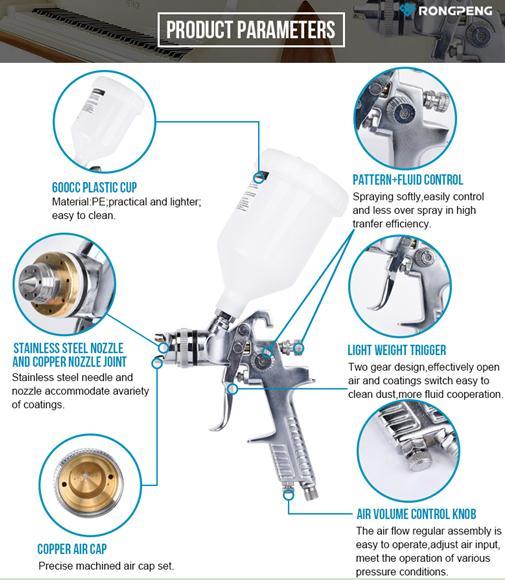For Beginners, How to Use a Paint Spray Gun
For Beginners, How to Use a Paint Spray Gun
As a kind of spraying pneumatic tool, the pneumatic spray gun consists of a nozzle and a gun body. It operates on the principle that the paint passing through the paint channel is quickly broken into very fine particles with extremely high air pressure, which is then ejected from the nozzle and adhered to the surface. In addition to its own precise structure and performance, the correct operation can make the spraying effect more effective. It is also important to have a good spray effect and master the skills. This article will explain the correct operation method.
Before using, you must first understand the function of its various components. For professional paint sprayers, the three spray width adjustment knobs (flow regulating knob, jetting regulating knob and pressure adjustment knob) are commonly used in the spraying process.
1. After opening the product packaging, please check carefully for any damage during transportation. Be sure to tighten the fittings and bolts before putting the equipment into service.
2. Thoroughly mix and dilute according to the manufacturer's instructions. Most materials can be easily sprayed if properly diluted.
3. Fill the tank with about 3/4 full and start the air compressor.
4. Adjustment
The desired pattern and fine atomization can be easily obtained by regulating the Pattern Adjusting Knob, Fluid (PAINT) Adjusting Knob.
Jetting ADJUSTMENT: Turning Pattern Adjusting Knob to the right until tight will make spray pattern round, or turning left make spray pattern ellipse.
Flow ADJUSTMENT: Turn the Paint Adjusting Knob clockwise will decrease the volume of fluid output and counter-clockwise will increase fluid output.
Pressure adjustment: Turn the knob for adjusting the air inlet volume.
5. Set up a piece of cardboard or other scrap material to use as a target and adjust for best spray pattern.
6. Test the spray shape and spray flow.
7. Start spraying.
Always keep the gun at right angles to the work. Keep the nozzle about 6-12 inches from the work surface. Trigger the gun properly.
Use a piece of cardboard as a shield to catch overspray at the edges of the work to protect other surfaces.
As a kind of spraying pneumatic tool, the pneumatic spray gun consists of a nozzle and a gun body. It operates on the principle that the paint passing through the paint channel is quickly broken into very fine particles with extremely high air pressure, which is then ejected from the nozzle and adhered to the surface. In addition to its own precise structure and performance, the correct operation can make the spraying effect more effective. It is also important to have a good spray effect and master the skills. This article will explain the correct operation method.
Before using, you must first understand the function of its various components. For professional paint sprayers, the three spray width adjustment knobs (flow regulating knob, jetting regulating knob and pressure adjustment knob) are commonly used in the spraying process.
1. After opening the product packaging, please check carefully for any damage during transportation. Be sure to tighten the fittings and bolts before putting the equipment into service.
2. Thoroughly mix and dilute according to the manufacturer's instructions. Most materials can be easily sprayed if properly diluted.
3. Fill the tank with about 3/4 full and start the air compressor.
4. Adjustment
The desired pattern and fine atomization can be easily obtained by regulating the Pattern Adjusting Knob, Fluid (PAINT) Adjusting Knob.
Jetting ADJUSTMENT: Turning Pattern Adjusting Knob to the right until tight will make spray pattern round, or turning left make spray pattern ellipse.
Flow ADJUSTMENT: Turn the Paint Adjusting Knob clockwise will decrease the volume of fluid output and counter-clockwise will increase fluid output.
Pressure adjustment: Turn the knob for adjusting the air inlet volume.
5. Set up a piece of cardboard or other scrap material to use as a target and adjust for best spray pattern.
6. Test the spray shape and spray flow.
7. Start spraying.
Always keep the gun at right angles to the work. Keep the nozzle about 6-12 inches from the work surface. Trigger the gun properly.
Use a piece of cardboard as a shield to catch overspray at the edges of the work to protect other surfaces.
